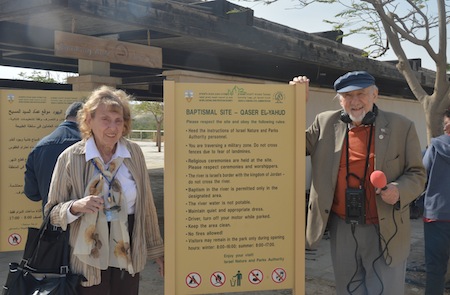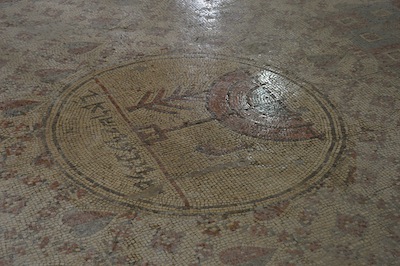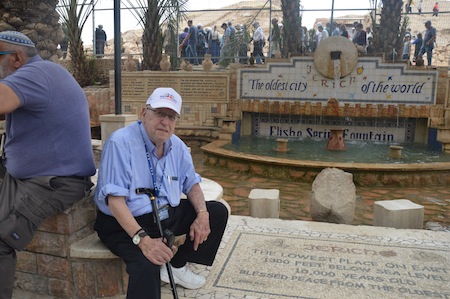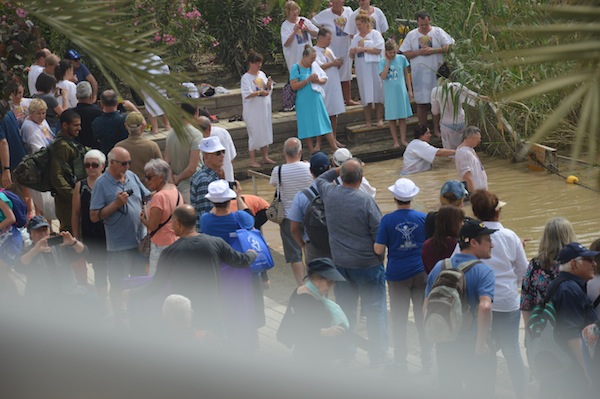Christians preparing to be baptized in the Jordan River. (photo by Barry Kaplan)
A few days prior to Passover, the Israeli Government Press Office organized a special field trip to the Jordan River and Jericho. The bus with 40 journalists left the GPO office parking lot at 8:30 a.m. and traveled on Highway #1 to the southern part of the Jordan Valley with a guide. We passed Maale Adumim, now a city with 45,000 residents, and headed through the desert area.
We began the ascent to Jericho, passing the Inn of the Good Samaritan, the sea-level sign and the barren hills. A strip of restaurants and souvenir places seemed to appear out of nowhere. We heard about the history of Kibbutz Bet Arevo, situated in this area from 1939 to 1948, passed a veritable forest of palm trees and, by 9:20 a.m., we were at Qasr al-Yahud, where John the Baptist is said to have baptized Jesus. After it passed through the security fence, the bus parked and we walked down to the Jordan River.
Until 1967, this site was under Jordanian control and, in 1968, access was prohibited. In recent years, the tourism and regional development ministries have carried out various projects, including the clearing of mines, and, in 2011, the site was opened to visitors. The site and facilities are overseen by the Israeli Civil Administration and the Israeli Ministry of Tourism as part of a national park.
Running down the middle of the Jordan River is a metal divider. On the other side of it is Jordan. There were people standing around the river and, behind them, churches were visible on the Jordanian side. On the Israeli side, down more steps, people were wearing white cover-ups and going into the river, presumably to be baptized.

In addition to its significance to Christians, two Jewish events took place at this spot.
In the Book of Joshua, we read how the Israelites, after 40 years of wandering in the desert, led by Joshua, crossed the Jordan River as the river became a stream. Supposedly this happened on the 10th of Nissan, this year April 15. Our guide says this could have taken place 4,440 years ago.
The passage in the Book of Joshua reads: “When the soles of the feet of the priests who bear the ark of the Lord, the Lord of all the earth, shall rest in the waters of the Jordan, that the waters of the Jordan shall be cut off, even the waters that come down from above, and they shall stand in one heap.” (Joshua 3:13)
At this point in our trip, we were joined by Uzi Dayan, former major general, national security adviser and Israel Defence Forces deputy chief of staff. According to Dayan, this passage from Joshua describes “the first aliyah to Israel.”
Another biblical text (2 Kings 2:1-2) says Elijah struck the Jordan River water with his cloak. The water parted so that he and Elisha could cross. After Elijah ascended, Elisha again parted the waters with Elijah’s cloak so he could return to Israel. This occurred before Elijah ascended to heaven in a fiery chariot.
Dayan noted that, on the day of our visit, there would be 17 other busloads of people coming to commemorate what has happened here, and that a ceremony would be held that afternoon. We would return for it, but not stay (as I will explain later).
* * *
At 11:10 a.m., we reboarded the bus and became part of a convoy, with IDF soldiers and jeeps leading us and several soldiers inside each bus. On one side of the road are mine fields, still being cleared.
Our next stop was the sixth- or seventh-century CE Shalom Al Yisrael Synagogue. Down some steps, we walked around the 10-by-13-metre mosaic floor that featured a menorah in its centre. It was identified as being the floor of a synagogue because of the images of the menorah, as well as an ark, shofar and lulav. The name stems from a mosaic inscription with the Hebrew words Shalom Al Yisrael.

The synagogue was probably used for hundreds of years, but then the Jericho Jewish community dissipated, and the synagogue was forgotten. It was revealed in excavations conducted in 1936 by Dimitri Baramki of the department of antiquities under the British Mandate.
After the 1967 Six Day War, the site came under Israeli military control and remained under the administrative responsibility of the Arab owners – the Shahwan family, who had built a house over the mosaic floor and charged admission to visit it. Tourists and Jews began visiting the site regularly for prayers. In 1987, the Israeli authorities confiscated the mosaic, the house and a small part of the farm around it. They offered compensation to the Shahwan family, but it was rejected.
After the 1995 Oslo Accords, control of the site was given to the Palestinian Authority. It was agreed that free access to it would continue, and that it would be adequately protected.
There have been some incidents. For example, on the night of Oct. 12, 2000, the synagogue was vandalized by Palestinians who torched and destroyed most of the building, burned holy books and relics, and damaged the mosaic. For more than eight years, no Jews were permitted in Shalom Al Yisrael Synagogue, but, during that time, it was restored by the Municipality of Jericho. Since 2007, prayer services have been allowed once a week.
* * *
By 12:15 p.m., we were at the tel (hill, or mound), which some journalists climbed. Opposite is a building with restaurants, snacks and a kind of enclosed mall. Israeli soldiers patrol the entire area. Outside, a man was giving rides to people atop a camel, and soldiers sat around and chatted.
The archeological site is about 2.5 kilometres north of modern-day Jericho, on the site of the ancient city, 258 metres below sea level. It was inhabited from the 10th century BCE. Excavations began in 1868 and settlements are known to date from 10000 BCE.

The story in the Book of Joshua relates that, when the Israelites were encamped in the Jordan Valley, ready to cross the river, Joshua, as a final preparation, sent out two spies to investigate the military strength of Jericho. The spies stayed in Rahab’s house, which was built into the city wall. The soldiers sent to capture the spies asked Rahab to bring out the spies; instead, she hid them.
After escaping, the spies promised to spare Rahab and her family after taking the city, if she would mark her house by hanging a red cord out the window. When Jericho fell, Rahab and her whole family were saved, becoming part of the Jewish people.
The biblical battle of Jericho was the first battle that was fought by the Israelites. According to Joshua 6:1-27, the walls of Jericho fell after Joshua’s army marched around the city and blew their trumpets.
* * *
Our second-last stop was Moshav Naama, which is about 45 minutes from the centre of Jerusalem and one-and-a-half hours from Tel Aviv. About 50 families live there. We arrived at 2 p.m.
On the moshav, they grow grapes, dates and organic vegetables. Inon, one of the farmers, grows herbs in greenhouses. In the warehouse, sweet basil and tarragon are packaged for shipping all over the world to supermarkets.
Inon said 95% of the dates grown there are Medjoul and 5% are other kinds. Medjoul dates originated in the Middle East and North Africa, and are one of the most famous varieties. They are well-known for their large size and delicious flavour. The dates from the moshav will be harvested in September and October.
* * *
At 4:30 p.m., above Qasr al-Yahud, the baptismal site, chairs have been set up for the approximately 900 people who will listen to speeches commemorating the Israelites arrival in the Promised Land. However, since most of the journalists do not understand the Hebrew, the GPO bus boards at 5:20 p.m. and travels back to the GPO offices, arriving just over an hour later. Even though we didn’t stay for the whole proceedings, I am still excited to have been a witness to the ceremony.
Sybil Kaplan is a journalist, lecturer, book reviewer and food writer in Jerusalem. She created and leads the weekly English-language Shuk Walks in Machane Yehuda, she has compiled and edited nine kosher cookbooks, and is the author of Witness to History: Ten Years as a Woman Journalist in Israel.
[For more on this press trip to the Jordan River and Jericho, see “Celebrating our history.”]

